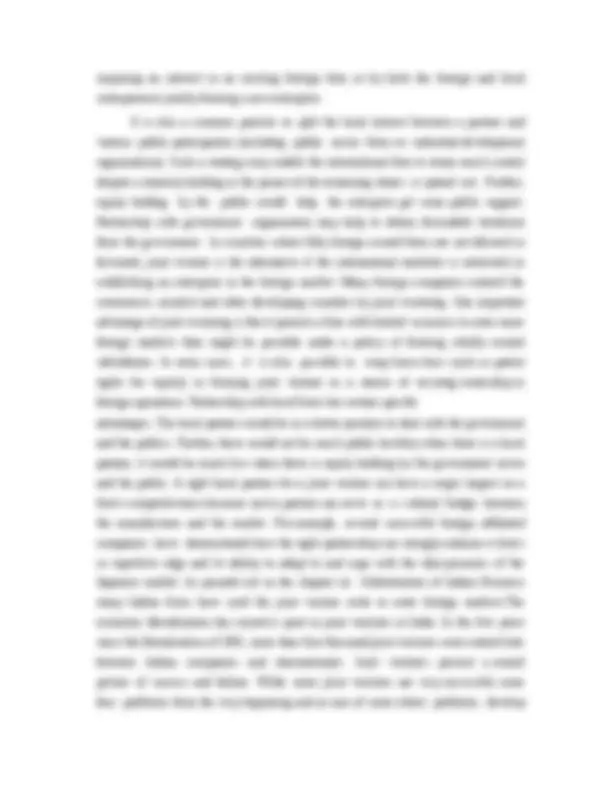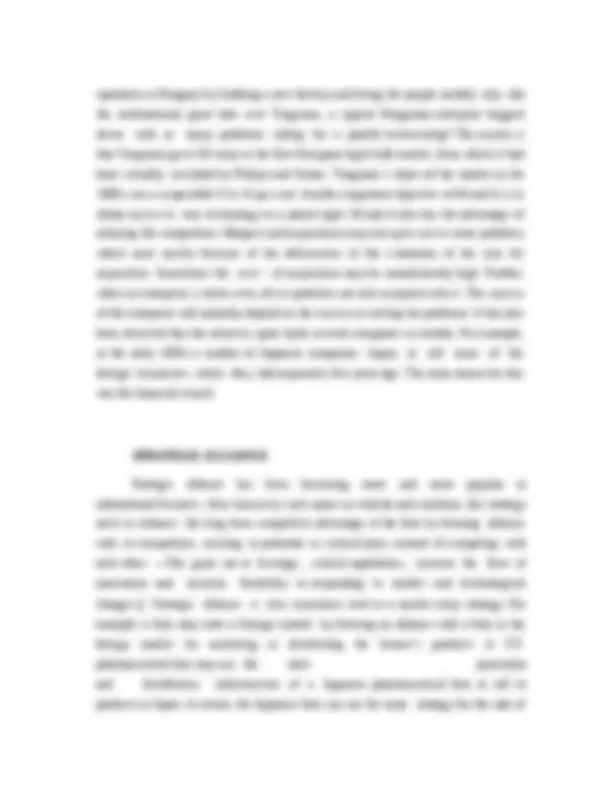







Study with the several resources on Docsity

Earn points by helping other students or get them with a premium plan


Prepare for your exams
Study with the several resources on Docsity

Earn points to download
Earn points by helping other students or get them with a premium plan
Community
Ask the community for help and clear up your study doubts
Discover the best universities in your country according to Docsity users
Free resources
Download our free guides on studying techniques, anxiety management strategies, and thesis advice from Docsity tutors
Companies with long term and substantial interest in the foreign market normally establish fully owned manufacturing facilities there. As Drucker points out, "it is simply not possible to maintain substantial market standing in an important area unless one has a physical presence as a producer. A number of factors like trade barriers,
Typology: Study notes
1 / 9

This page cannot be seen from the preview
Don't miss anything!






Companies with long term and substantial interest in the foreign market normally establish fully owned manufacturing facilities there. As Drucker points out, "it is simply not possible to maintain substantial market standing in an important area unless one has a physical presence as a producer. A number of factors like trade barriers, differences in the production and other cost s, government policies etc. encourage the establishment of production facilities in the foreign markets. More information about this is provided in the chapter on International Investment. Establishment of manufacturing facilities abroad has several advantages. It provides the firm with complete control over production and quality. It does not have the risk of developing potential competitors as in the case of licensing and contract manufacturing. Wholly owned manufacturing facility has several disadvantages too. In some cases, the cost of production is high in the foreign market. There may also be problems such as restrictions regarding the types of technology, non-availability of skilled labour, production bottlenecks due to infrastructural problems etc. If the market size is small, a separate production unit for the market may be uneconomical. Foreign investment also entails political risks. Fully owned enterprises may not be allowed or favoured in some countries, particularly in low priority areas. Moreover, this method demands sufficient financial and managerial resources on the part of the company.
ASSEMBLY OPERATIONS As Miracle and Albaum point out, a manufacturer who wants many of the advantage that are associated with overseas manufacturing facilities and yet does not want to go that far may find it desirable to establish overseas assembly facilities in selected markets. In a sense, the establishment of an assembly operation represents a cross between exporting and overseas manufacturing. Having assembly facilities in foreign markets is very ideal when there are economies of scale in the manufacture of parts and components and when assembly operations are labour intensive and labour is cheap in the foreign country. It may be noted that a number of U.S. manufacturers ship the parts and components to the developing countries, get the product assembled
there and bring it back home. The U.S. tariff law also encourages this. Thus, even products meant to be marketed domestically are assembled abroad. Assembling the product meant for the foreign market in the foreign market itself has certain other advantages, besides the cost advantage. The import duty is normally low on parts and components than on the finished product. Assembly operations would satisfy the 'local content' demand, at least to some extent. Because of the employment generation, the foreign government's attitude will be more favorable than towards the import of the finished product. Another advantage is that the investment to be made in the foreign country is very small in comparison with that required for establishing complete manufacturing facilities. The political risk of foreign investment is, thus, not much.
JOINT VENTURES Joint venture is a very common strategy of entering the foreign market. In the widest sense, any form of association which implies collaboration for more than a transitory period is a joint venture (pure trading operations are not included in this concept). Such a broad definition encompasses many diverse types of joint overseas operations, viz.,
Three of the above have already been discussed in the preceding sections. The following paragraphs are confined to the first category referred to above, i.e., joint ownership ventures. What is often meant by the term joint venture is joint ownership venture. The essential feature of a joint ownership venture is that the ownership and management are shared between a foreign firm and a local firm. In some cases there are more than two parties involved. For example, Pepsi's Indian joint venture involved Voltas and Punjab Agro Industries Corporation. A joint ownership venture may be brought about by a foreign investor buying an interest in a local company, a local firm
after a period of mutual benefit and success. A Mckinsey world wide study of more than 200 alliances (principally joint ventures) has shown that the median life span of them is only seven years and in more than 80 per cent of the cases, it ends in one partner selling out to the other.In fact, joint ventures are not necessarily meant to be permanent. They are meant to serve specific objectives within a period of time and once the objectives are achieved the continuation depends on the reassessment of the situation by the partners. A number of joint ventures fail to achieve the objectives by either or both the partners and this could naturally result in the breakdown of the alliance. A joint venture may go through ―several points of crisis, caused by the realisation on the part of either — sometimes both — of the partners that its expectations are not being fulfilled and, perhaps, even being negated‖. Chances
of such flash points are more with the flattening out of the gains curve on any of the parameters that govern either partner's decision to be involved in the joint venture. For, at this point, the gains of one of the partners become disproportionate to those of the other, leading the former to re-examine the rationality of retaining the relationship." Such flash points, however, need not necessarily result in the termination of the joint venture, they may be managed so that there will be more equitable gains from the joint venture. One of the important reasons for the failure of joint ventures in India is the unequal resource and bargaining powers of the partners. The new business environment that resulted from the liberalisation has increased the cases of failures on account of this factor. Many transnationals wanted to hike their share in the equity of the joint venture. This was the reason for the end of the 28 year old partnership between Royal Dutch Shell and NOCIL. Now that foreign firms are able to set up fully owned subsidiaries, a number of foreign firms have turned to such ventures, discarding or neglecting their existing joint ventures in the country. There are also several cases of the Indian partner‘s stake, fully or partially, sold to the foreign partner because of financial problems. Similarly, the Indian partner is unable to match with the resourceful foreign firm in bringing in additional funds for expansion, the Indian partner‘s share of the equity holding falls. A joint venture can succeed only if both the partners have something definite to offer to the advantage of the other, and reap definite advantages, and have mutual trust and respect.
Third country location is some times used as an entry strategy. When there is no commercial transactions between two nations because of political reasons or when direct transactions between two nations are difficult due to political reasons or the like, a firm in one of these nations which wants to enter the other market will have to operate from a third country base. For example,
operation in Hungary by building a new factory and hiring the people needed, why did the multinational giant take over Tungsram, a typical Hungarian enterprise bogged down with so many problems calling for a painful restructuring? The answer is that Tungsram gave GE entry to the East European light bulb market, from which it had been virtually excluded by Philips and Osram. Tungsram‘s share erf the market in the 1980s was a respectable 9 to 10 per cent. Another important objective of M and A is to obtain access to new technology or a patent right. M and A also has the advantage of reducing the competition. Mergers and acquisitions may also give rise to some problems which arise mostly because of the deficiencies of the evaluation of the case for acquisition. Sometimes the cost > of acquisition may be unrealistically high. Further, when an enterprise is taken over, all its problems are also acquired with it. The success of the enterprise will naturally depend on the success in solving the problems. It has also been observed that the takeover spree lands several companies in trouble, For example, in the early 1990s a number of Japanese companies began to sell some of the foreign businesses which they had acquired a few years ago. The main reason for this was the financial crunch.
Strategic alliance has been becoming more and more popular in international business. Also known by such names as entente and coalition, this strategy seeks to enhance the long term competitive advantage of the firm by forming alliance with its competitors, existing or potential in critical areas, instead of competing with each other. ―The goals are to leverage ; critical capabilities, increase the flow of innovation and increase flexibility in responding to market and technological changes.‖ Strategic alliance is also sometimes used as a market entry strategy. For example, a firm may enter a foreign market by forming an alliance with a firm in the foreign market for marketing or distributing the former‘s products. A U.S. pharmaceutical firm may use the sales promotion and distribution infrastructure of a Japanese pharmaceutical firm to sell its products in Japan. In return, the Japanese firm can use the same strategy for the sale of